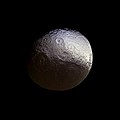PIA19062: Investigating Subtle Colors on Iapetus
http://photojournal.jpl.nasa.gov/catalog/PIA19062
Cassini stared toward Saturn's two-toned moon Iapetus (914 miles or 1,471 kilometers across) for about a week in early 2015, in a campaign motivated in part to investigate subtle color differences within the moon's bright terrain.
This distant flyby represents Cassini's second-closest approach to Iapetus in the current mission phase; a slightly closer encounter took place in 2011. It is the only set of observations with a good view of the bright terrain in the moon's north polar area.
The large basin at lower right, within the dark terrain, is named Turgis. The slightly smaller crater at the nine o'clock position is Falsaron. The two prominent craters just above image center are Roland and Turpin. At the limb around the three o'clock position is the darkened rim of the crater Naimon.
Images taken using red, green and blue spectral filters were combined to create this natural-color view. The moon's brightness has been enhanced in order to make the dark terrain visible. The image also was enlarged by a factor of two compared to the original data.
The view was obtained by the Cassini spacecraft narrow-angle camera on March 27, 2015 at a distance of approximately 621,000 miles (1 million kilometers) from Iapetus and at a Sun-Iapetus-spacecraft, or phase, angle of 38 degrees. Image scale on Iapetus is about 4 miles (6 kilometers).
The image was produced by Tilmann Denk at Freie Universität in Berlin.
The Cassini-Huygens mission is a cooperative project of NASA, the European Space Agency and the Italian Space Agency. The Jet Propulsion Laboratory, a division of the California Institute of Technology in Pasadena, manages the mission for NASA's Science Mission Directorate, Washington, D.C. The Cassini orbiter and its two onboard cameras were designed, developed and assembled at JPL. The imaging team is based at the Space Science Institute, Boulder, Colo.
For more information about the Cassini-Huygens mission visit
http://saturn.jpl.nasa.gov and
http://www.nasa.gov/cassini. The Cassini imaging team homepage is at
http://ciclops.org.





